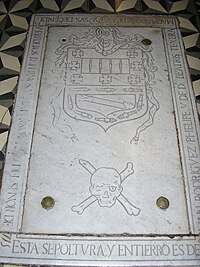Iglesia de Santo Domingo de Guzmán (San Cristóbal de La Laguna)
This article needs additional citations for verification. (April 2016) |
| Church of Saint Dominic | |
|---|---|
 | |
 | |
| Location | San Cristóbal de La Laguna |
| Country | |
| Denomination | Roman Catholic |
| Architecture | |
| Functional status | Active |
| Completed | 1522 (Monastery) 1527 (Church) |
| Administration | |
| Archdiocese | San Cristóbal de La Laguna |
The Iglesia de Santo Domingo de Guzmán (Church of the Saint Dominic of Guzmán) it is a Catholic church located in the city of San Cristóbal de La Laguna (Tenerife, Canary Islands, Spain).
History
In the place of the present temple, there is a primitive chapel dedicated to the Immaculate Conception. In 1522 the convent where the Dominican friars established is constructed. Meanwhile, in 1527 the church is built.
In this Dominican temple was guarded the image of the Virgin of Candelaria (Patron Saint of the Canary Islands) in his first outing of the town of Candelaria, 30 January 1555. This first transfer to the French was by fear and attacks that had been made previously on the coast, a place where your sanctuary.[1]

In 1612, a chair of theology was created, contributing to the expansion and importance of the convent, which also came to have a public library. In 1747 he was buried in this church the famous pirate Amaro Pargo. Such pirate was patron of this temple, who donated several works of art, like the silver throne of the Jesus deceased. His marble headstone is located right at the entrance of the church. This is the family crest and the pirate symbol, a skull and crossbones.
In addition, the temple is the baptismal font with which he was baptized St. José de Anchieta, although this saint was baptized in the Parish of Virgin of Los Remedios the city (now the cathedral of the Diocese). Anchieta founded the city of Sao Paulo, and was one of the founders of Rio de Janeiro in Brazil.
After the creation of the Roman Catholic Diocese of San Cristóbal de La Laguna, the Church of Santo Domingo was for a time Parish of Church tabernacle of the Cathedral of Our Lady of Remedios.
In the main altar stands the chapel of the Our Lady of the Rosary, which is an image possibly brought to the island of Tenerife, by the Dominican friar Pedro de Santa María de Ulloa, although it is possible that size were already in the island from 1558. the image is in a spectacular silver throne eighteenth century.
Today, the church and the former convent are of cultural interest of the Canary Islands with the Monument category since 1986.
See also
References
- ^ "La Virgen de Candelaria ha visitado la ciudad 38 veces". Eldia.es. 2009-05-09. Retrieved 2016-04-21.
